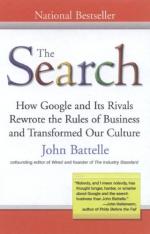
|
| Name: _________________________ | Period: ___________________ |
This test consists of 15 multiple choice questions and 5 short answer questions.
Multiple Choice Questions
1. What angers webmasters in the early stages of Google?
(a) They cannot find their websites as easily as in other search engines.
(b) Google is charging a listing fee for websites to be included in its directory.
(c) They resent the speed at which Google is growing compared to other search engines.
(d) Their websites earn a lower ranking than others.
2. What happens when Page tries to sell Google to other Internet companies?
(a) The companies are not interested.
(b) The companies attempt to use the information Page gives them to make their own websites better.
(c) The companies do not understand how to operate Google.
(d) The companies do not offer enough money.
3. How does the media view Google in 2002?
(a) As an honest company.
(b) As a failing company.
(c) As a deceitful company.
(d) As a company that is growing too fast.
4. What does Susan Wojcicki rent to Page and Brin for them to use to develop further technology?
(a) A room in her house.
(b) A computer lab.
(c) A garage.
(d) An office building.
5. Who does Battelle fear will use clickstream data to abuse the privacy of Internet users?
(a) Search engine companies.
(b) Website owners.
(c) Other Internet users.
(d) The government.
6. In the A, B, C, D hiring model, which type of employees do "A grade" employees tend to hire?
(a) C grade employees.
(b) B grade employees.
(c) Other A grade employees.
(d) D grade employees.
7. Why is clickstream data so important to search engines?
(a) It tells them how often people use the Internet.
(b) It gives them the total number of clicks to a website so they can charge that particular website accordingly.
(c) It helps them analyze the preferences of Internet users to present them with effective advertising.
(d) It provides them with the personal ISP number for Internet users, which is used to contact them in the future.
8. How long does Schmidt take before understanding the place of a search engine and agreeing with Battelle?
(a) He never agrees with Battelle.
(b) Two years.
(c) One year.
(d) Three years.
9. How much funding do Page and Brin receive from Andy Bechtolsheim?
(a) $150,000.
(b) $50,000.
(c) $10,000.
(d) $100,000.
10. In what year did Alan Emtage create Archie, the first Internet search engine?
(a) 1990.
(b) 1991.
(c) 1988.
(d) 1985.
11. After much consideration, what core value does Google adopt as its motto in 2001?
(a) We're Not Evil.
(b) Don't Be Evil.
(c) Why Be Evil?
(d) The Alternative to Evil.
12. What does Google add to the concept of parallel computing to make it even more beneficial?
(a) Twice as much hardware to double their results.
(b) The notion of allowing other companies access to their hardware to cut operating costs.
(c) Huge, cost-effective scaling by using inexpensive hardware.
(d) The plan to build all of their own hardware to reduce labor and equipment costs.
13. What is especially fascinating about the story of how Larry Page and Sergey Brin worked together to create Google?
(a) They were both best friends before they were business partners, which is why they were successful.
(b) They did not like each other at first, but both become business partners out of their common interest in building something useful.
(c) Neither one of them had actually used a computer before they met and decided to create a search engine.
(d) Most of their friends and associates did not believe in their idea and tried to discourage them from pursuing it, but they did not listen.
14. Where did Monier end up working after AltaVista was sold and reworked?
(a) EBay.
(b) AOL.
(c) Google.
(d) Yahoo.
15. Why was AltaVista.com groundbreaking?
(a) It used an advanced computer system to analyze keywords on a daily basis.
(b) It was the first search engine to remember specific data of Internet users.
(c) It contained an index of all web pages at the time.
(d) It listed a description of each website next to the title.
Short Answer Questions
1. Why do advertisers like Gross' marketing system?
2. What is the average response rate for paid ads on Google or Yahoo?
3. What position does Jeff Bezos hold when he remarks that you "shouldn't have to brag" about not being evil in response to Google's recently announced motto.
4. IdeaLab initially operates on what theory about developing new business ideas?
5. What Palo Alto street does Google relocate to after outgrowing its current location in 1999?
|
This section contains 815 words (approx. 3 pages at 300 words per page) |

|




